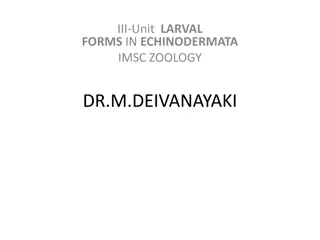Understanding Retrogressive Metamorphosis in Ascidian Tadpoles
Retrogressive metamorphosis in ascidian tadpoles involves a unique transformation where advanced larval features are lost during development, leading to a sedentary or degenerated adult form. Ascidians, also known as sea squirts, exhibit this type of metamorphosis, shedding their chordate characteristics as they transition from a mobile larval stage to an immobile adult stage. This process highlights the intriguing evolutionary adaptations within the Urochordata class of marine invertebrates.
Download Presentation

Please find below an Image/Link to download the presentation.
The content on the website is provided AS IS for your information and personal use only. It may not be sold, licensed, or shared on other websites without obtaining consent from the author. Download presentation by click this link. If you encounter any issues during the download, it is possible that the publisher has removed the file from their server.
E N D
Presentation Transcript
Retrogressive metamorphosis in ascidian tadpole
Metamorphosis? Metamorphosis is transformation of a larva into an adult is termed as metamorphosis. Or Metamorphosis is a post embryonic extension of the development potential and involves dramatic changes in habitat, morpholology, physiology, and behavior of larva so that it is transformed into the adult having entirely different habitat and structure. a type of process in which
Two Basic Types Of Metamorpsis 1.Retrogressive Metamorphosis:-It occurs in ascidians where only the larvae posses chordate feature, the adult, adapted to a sessile existence, loss all larval locomotory organs and thereby give up all the traces of chordate relationship. 2.Progressive Metamorphosis:- It occurs in amphibians and insect and include changes of simple larval organization into more complexorganization of the adult.
Ascidian Ascidiacea (commonly known as the ascidians or sea squirts) is a class in the subphylum Tunicata of sac-like marine invertebrate filter feeders. Ascidians are characterized by a tough outer "tunic" made of the polysaccharide tunicin, as compared to other tunicates which are less rigid. Ascidians are found all over the world, usually in shallow water with salinities over 2.5%. While members of the Thaliacea and Larvacea swim freely like plankton, sea squirts are sessile animals: they remain firmly attached to substratum, such as rocks and shells.
Metamorphosis is a change from the juvenile to adult stage in which larval stage is quite different from the adult stage. In retrogressive metamorphosis the larva possesses advanced characters which are lost during the development and the adult is either sedentary or degenerated with primitive characters. Urochordate adults, degenerative characters while the free swimming tadpole larva shows advanced chordate characters which are lost during metamorphosis. During metamorphosis the larva will loose all the chordate characters and attains an invertebrate like form. This type of metamorphosis, where highly advanced larval form ends in a slowly organized adult is called retrogressive metamorphosis being sedentary show
Retrogressive metamorphosis is characteristic of ascidians (Urochordata or Tuncicata). It is given this name because here a progressive, active and alert larva metamorphoses into a retrograde and sedentary adult. Ascidians are marine, sedentary, bag-like creatures that remain attached to a rocky substratum all their lives and use a current of water passing through their large and perforated microorganisms on which they fads. The larva, on the other hand, is active, tadpole-like in shape and has all the three chordate features, gill clefts, notochord and dorsal tubular nerve cord. Most of these characters are lost or become degenerate as the active larva metamorphosis's. Hence, the term retrogressive metamorphosis. pharynx to collect
The retrogressive metamorphosis is a peculiar and uncommon process in the chordates, although such phenomenon is observed in some non- chordate animals
Structure of early tadpole larva A fully grown tadpole larva is highly motile and does not take food from outside, i.e., it is a non- feeding form. It has an elongated body. The body is more or less oval in outline. It is distinctly divisible into two regions the head and the tail The whole of the body is covered over by the tunic. The head is elliptical and has three adhesive papillae or chin warts. Of the chin warts, one is mid- dorsally placed and the rest two are located ventrolaterally. The adhesive papillae secrete adhesives that are used for settlement at the onset of metamorphosis. The tail is laterally compressed and pointed terminally. It is provided with a caudal fin. The dorsal and ventral fins are continuous along the tail and are marked with 36 uni-nucleated, striae. The striae are regarded to be precursors of the fin-rays in fishes. The central nervous system is situated dorsal to the notochord. It enlarges anteriorly into a sensory vesicle which opens into the pharynx near the mouth by neuropore.
A single median eye containing the retina, pigmented layer, cornea and lens, is present in the inner wall of the hollow sensory vesicle. An otocyst (statocyst), the organ of balance, is also situated in its ventral side and the rear wall usually bears an ocellus. The slender nerve cord is not much differentiated but is hollow throughout. The nerve cord is composed of a single layer of ependymal cells. The notochord is restricted only in its tail region. It extends anteriorly up to the pharyngeal region and is en-sheathed by gelatinous materials. Segmental muscle bands are present in the tail region, which are arranged on both the sides of the nerve cord. The mouth is present and the alimentary canal is rudimentary. The pharynx is sac-like and is well- developed. It bears a fully developed endostyle and two pairs of gill-slits. Non-functional heart with epicardia lies beneath the endostyle. The paired atrial sacs are present. Just after hatching the tadpole larva becomes positively phototactic and negatively geotactic.
Cloney (1982) classified the ascidian tadpole structures into 3 categories
Settlement and metamorphosis: The free swimming tadpole larva, after a short period of free existence, becomes sluggish. It soon fixes itself to sea weeds or stones by adhesive papillae and immediately falls a victim of fast degeneration. At this stage the larva becomes negatively phototactic and positively geotactic. Some authors believe that habitat selection is a main cause for the metamorphosis of ascidian tadpole larva.
Habitat selection: Berrill (1955) has emphasised the importance of habitat selection in the life of the ascidians. It is interesting to note that many species cannot survive at all if the larvae settle at any substratum other than hard and rocky places. Moreover, just after settlement on the mud and detritus may suffocate these creatures.
Retrogressive changes: Just after fixation the length of the tail becomes greatly diminished. The nerve cord becomes restricted to the trunk region and is ultimately reduced to a solid nerve ganglion. The notochord becomes coiled, disorganised, and finally disappears. The trunk becomes broadened. The mouth is shifted to 90 from the point of attachment
Shifting of the mouth is caused by the rapid growth of the region between the adhesive papillae and mouth, and also due to inhibition of growth of the original dorsal side. As development goes on, the tail becomes still more shortened and is partially withdrawn into the test. The rotation of the mouth is clearly marked.
Progressive changes: During metamorphosis, from the tadpole larva to the adult, all the changes are not necessarily degenerative but some structures, which are intimately associated with their survival, become more elaborated and specialized. The progressive changes are: The branchial chamber becomes enlarged and the number of stigmata are enhanced. The post-pharyngeal portion of the gut gets regionated into different parts. The atrium becomes more extensive. The development of velum is observed. The gonads and gonoducts appear from the mesoderm.
The essence of retrogressive metamorphosis in Ascidia is: (i) the differential growth and disappearance of histologically differentiated larval tissues and (ii) the formation of the adult structures from the residual larval tissues. In ascidian metamorphosis, two sets of changes occur. First, the disappearance of notochord, dorsal nerve cord and tail, and secondly, the elaboration of some adult structures likes the formation of stigmata, specialisation of pharynx, overdevelopment of atrium, etc.
Experimental analysis for the metamorphosis of ascidian tadpole: Some physical and chemical factors are concerned with the metamorphosis of ascidian tadpole. Herdman regards phagocytosis as the primary cause of larval tissue destruction while Berrill (1929) advocates that the relative tissue starvation is responsible for larval tissue destruction. Grave (1935) believes that a metabolic product of swimming activity is essential for metamorphosis.
Grave metamorphosis of tadpole is conditioned by two factors: (1935) concludes that normal (i) Ageing of the larva after the liberation, and (ii) Swimming activity.
Glaser and Angslow (1949) attempted to assign the controlling role metamorphosis, released in the tadpole tissues. Some other factors like metabolic ions, iodine, low concentrations of vital dyes, some amino acids, thyroxine extracts, exposure to hypotonic sea water, dimethyl sulpoxide, acetylcholine and favourable condition may be recorded to accelerate the metamorphosis. of copper during lightening
Molecular analysis of Ascidian meta- morphosis: Scientists have succeeded to isolate some genes which are related to ascidian metamorphosis. Five novel genes manx, lynx, cymric, p58 and bobcat have isolated from the ascidian species. Lynx and Cymric are maternal and experiments are underway to see their roles in the development. Manx, p58 and bobcat are expressed both maternally and zygotically in the tailed species, and antisense experiments suggest a role in the specifying the body plan during development. Bobcat is also seen to be expressed in the neural tube of chordate embryos. In addition, 132 different protein coding sequences have been isolated, of which 65 of these transcripts show significant matches to Gen Bank proteins. Some of these genes have putative functions relevant to metamorphic events, related to the differentiation of muscles, blood cells, heart tissue and adult nervous sys- tems.
One set of genes that are activated at metamorphosis are the innate immunity genes. These genes are related to the expression of immune system which remodeling the body metamorphosis. In addition, this immune system may be necessary for phagocytosis and restructuring of larval tissues. are critical plan for during























